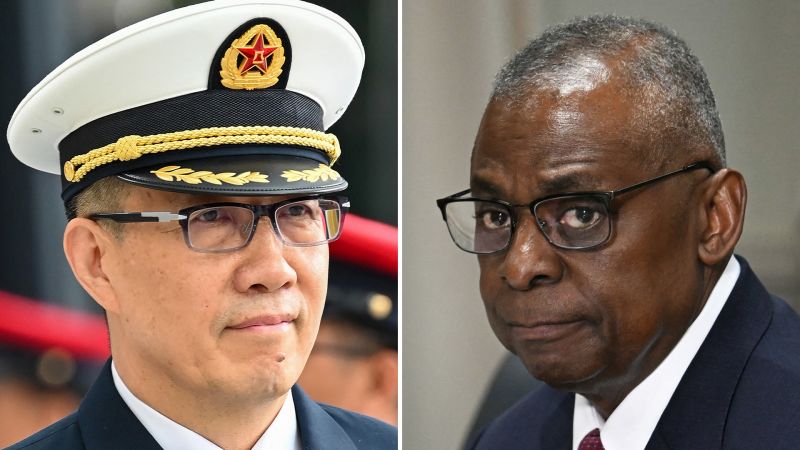
US and Chinese defense chiefs hold first in-person talks since 2022
The US and Chinese defense chiefs are holding a rare in-person meeting Friday as the two powers navigate a contentious security landscape across the Asia-Pacific and a range of frictions between them from China’s intimidation of Taiwan to American’s strengthening alliances in the region.
The meeting, between US Defense Secretary Lloyd Austin and China’s Minister of National Defense Adm. Dong Jun, is the first face-to-face talks between the two defense chiefs and Austin’s first such discussions with a Chinese counterpart since late 2022.
The meeting, on the sidelines of an annual defense conference in Singapore, takes place against a fraught regional backdrop. Beijing – which wields the world’s largest navy – continues to aggressively assert disputed territorial claims in the East and South China Seas, while decrying Washington’s efforts to strengthen security ties with key allies like Japan, South Korea and the Philippines.
China earlier this month staged major war games around Taiwan following the inauguration of the island’s new democratically elected president. China’s ruling Communist Party claims the self-governing democracy as its own, despite never having controlled it.
Its Coast Guard in recent weeks has also fired water cannons and sought to counter Philippine vessels operating in disputed areas of the South China Sea, stoking already heightened tensions with a US treaty ally in the region.
Beijing has also lashed out at what it sees as provocative moves between the US and its allies, with its Defense Ministry spokesperson on Thursday condemning the deployment of an American missile system during military drills in the Philippines last month.
Austin is expected to raise concerns with Dong about China’s support for Russia, US officials said ahead of the meeting. Washington in recent weeks has said dual-use exports from China are bolstering Russia’s defense industrial base as it wages war in Ukraine, with US officials warning Beijing against providing Russia with any lethal equipment.
Talks between Austin and Dong are not expected to see substantive progress towards resolving many entrenched issues between them.
At the core of those contentions is that China does not want to see America exercise its military power in Asia – a region where the US it has deep, historic security ties and seeks to maintain open waterways and deter North Korean aggression, but where China is widely viewed as wanting to establish its dominance.
But their meeting is seen by international observers as a positive step toward enhancing dialogue that could help to avoid miscommunication or military mishap veering toward conflict.
Severed ties
The face-to-face follows a call last month between Austin and Dong, who was appointed to his post in late December. The call marked Austin’s first at-length conversation with a Chinese counterpart since November 2022.
Beijing had largely suspended high-level military communications following a visit in August of that year from then-US House Speaker Nancy Pelosi to Taiwan, which sparked Beijing’s ire.
The silence coincided with a period of significant tensions between the two powers, which included high-profile incidents such as a Chinese spy balloon traversing across the continental US and what the US described as an increase in “coercive and risky” behavior by Chinese pilots against US aircraft over the East and South China Seas.
US efforts to re-engage appeared further complicated by the appointment in early 2023 of China’s previous Defense Minister Li Shangfu, who had been sanctioned by the US in 2018 over China’s purchase of Russian weapons.
Austin and Li had a brief exchange during last year’s Shangri-La Dialogue, but no formal talks, with Beijing repeatedly suggesting that the US defense secretary won’t get a meeting with Li unless the sanctions were revoked.
Efforts to stabilize that communication hit another complication after Li abruptly vanished from the public eye last August amid a personnel shake-up in Chinese leader Xi Jinping’s military ranks.
Li was formally removed from his post without explanation in October and replaced by Dong, a former naval commander, some two months later.
In China, the defense minister is a largely ceremonial role, serving as the public face of military diplomacy with other countries, while command power resides within the Chinese Communist Party’s powerful Central Military Commission led by Xi.
Xi and US President Joe Biden had vowed to restore high-level military talks during a summit outside San Francisco in November, seen by both sides as a key step in stabilizing fractious relations.
Several weeks later, US and Chinese top generals spoke in a video call, paving the way for this week’s in-person meeting between the defense chiefs.
